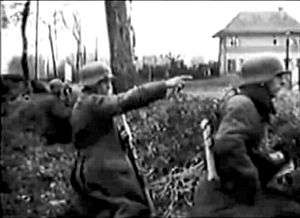Gumbinnen Operation
| Gumbinnen Operation | |||||||
|---|---|---|---|---|---|---|---|
| Part of Eastern Front of World War II | |||||||
 German troops on the outskirts of Gołdap, retaken on 3 November 1944 | |||||||
| |||||||
| Belligerents | |||||||
|
|
| ||||||
| Commanders and leaders | |||||||
|
(Army Group Centre) |
(3rd Belorussian Front) | ||||||
| Strength | |||||||
| ? | 404,500[1] | ||||||
| Casualties and losses | |||||||
| ? | 16,819 irrecoverable; 62,708 wounded[1] | ||||||
The Gumbinnen Operation,[2] also known as the Goldap Operation (or Goldap-Gumbinnen Operation, Russian: Гумбиннен-Гольдапская наступательная операция), was a Soviet offensive on the Eastern Front late in 1944, in which forces of the 3rd Belorussian Front attempted to penetrate the borders of East Prussia.
The offensive failed, due to strong resistance by the Wehrmacht. As a result, it is largely known through German accounts of the defence and because of the atrocities that were committed by troops of the 11th Guards Army, the so-called Nemmersdorf massacre.
Planning
The operation was planned as a result of the success of the Memel Offensive Operation to the north. The troops of the 1st Baltic and 3rd Belorussian Fronts had succeeded in pushing the Third Panzer Army back to the East Prussian border, surrounding the city of Memel and reaching the shore of the Curonian Lagoon. Stavka permitted Chernyakhovsky to further exploit this success by attacking along the Gumbinnen - Insterburg - Königsberg axis deep into East Prussia.
Chernyakhovsky's plan involved using the 5th and 11th Guards Armies to break open the German defensive lines, before pushing through exploitation forces from the 2nd Guards Tank Corps and 28th Army. The 31st and 39th Armies would advance on the flanks of the main force.
The opposing German forces, from the Third Panzer and Fourth Armies, were aided by the presence of substantial fortifications, and had been heavily reinforced.
Deployments
Wehrmacht
- Army Group Centre (Colonel-General Georg-Hans Reinhardt)
- Southern flank of Third Panzer Army (General Erhard Raus)
- XXXX Panzer Corps (General Sigfrid Henrici)
- IX Corps (General Rolf Wuthmann)
- Northern flank of Fourth Army (General Friedrich Hoßbach)
- XXVII Corps (General Maximilian Felzmann)
- XXXXI Panzer Corps (General Helmuth Weidling)
- Fallschirm-Panzerkorps Hermann Göring (Lieutenant-General Wilhelm Schmalz)
- VI Corps (General Horst Großmann)
- Southern flank of Third Panzer Army (General Erhard Raus)
Red Army
- 3rd Belorussian Front (General Ivan Chernyakhovsky)
- 11th Guards Army (Colonel-General Kuzma Galitsky)
- 5th Army (Colonel-General Nikolay Krylov)
- 28th Army (Lieutenant-General Luchinsky)
- 39th Army
- 31st Army
The offensive
On 16 October, the 5th and 11th Guards Armies went onto the offensive and initially penetrated some 11 km into the German defensive belt. The flanking armies commenced operations the next day, by which time units of the 11th Guards Army had crossed the East Prussian border.
The Soviet troops ran into extremely strong resistance, however. It took them four days to penetrate the initial tactical defences, while the second defence line was so strong that Chernyakhovsky was compelled to commit the 2nd Guards Tank Corps to break it. Casualties were extremely heavy. On 20 October, the second line was ruptured by the 11th Guards Army and 2nd Guards Tank Corps east of Gumbinnen, defended by the guns of the 18th Anti-Aircraft Division and the Fallschirm-Panzerkorps Hermann Göring, which had been redeployed in the area to counter the Soviet advance. On 21 October, the Soviets' reserve, the 28th Army, was committed, but the offensive in the north was fought to a standstill in the region of Stalluponen thanks to some effective German counter-attacks.
Gumbinnen was taken by 22 October, but retaken by German forces on the 24 October, after the Germans committed the 5th Panzer Division, and Heavy Panzer Detachment 505 (equipped with Tiger IIs). Units of 11th Guards Army found themselves cut off in the area of Großwaltersdorf, and were involved in intense fighting. In the meantime, the Germans had pressed more reserves, including the 102nd Panzer and Führer Grenadier Brigades into counter-attacks at Gołdap, on the southern sector of the Soviet penetration. The town was retaken on 25 October.
The Soviet attacks continued until 27 October, as the flanking armies sought to close up to the 11th Guards Army.
There was more fighting in the operation's immediate aftermath: on 28 October, the 31st Army retook Gołdap in a surprise attack; the town was again taken by the 5th Panzer Division, which was redeployed from the Gumbinnen area, on 3 November.
See also
- East Prussian Offensive, in which the Front renewed its attack into East Prussia the following January, this time successfully.
Further reading
- General Horst Großmann, commander of the German VI Corps, co-authored Der Kampf um Ostpreußen, which deals with the actions in some detail from the German perspective.
References
- Dieckert, K. and Großmann, H. Der Kampf um Ostpreußen, Gräfe und Unzer Verlag, München, 1960
- Glantz, D. The Failures of Historiography: Forgotten Battles of the Soviet-German War, http://fmso.leavenworth.army.mil/documents/failures.htm